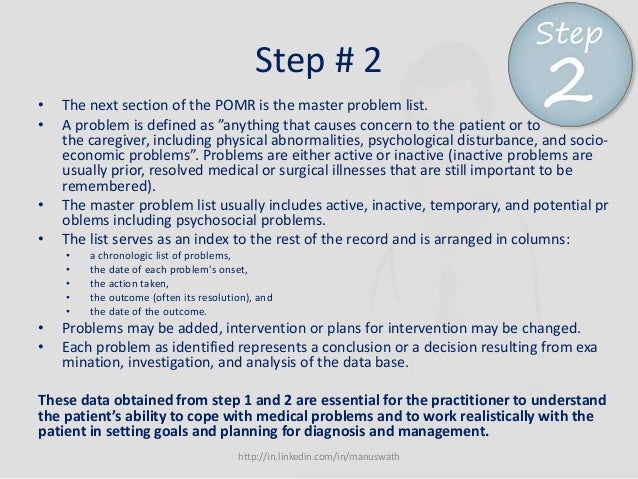Patient medical records johns hopkins medicine.
Pomr is the official method of keeping records used by most medical centers around the world as well as most undergraduate medical schools. pomr stores information in a way that can be easily accessed and promotes. continuous review and revisions of the healthcare plan by every member of the healthcare team. Figure. electronic health records (ehrs) are consistently used by external organizations to track the quality of care provided based on the information documented in the medical record, which affects hospital accreditation and reimbursement. patient oriented medical record 1 however, there's concern that technology may cause some patients to feel as if nurses and other practitioners are documenting for the institution.
Medical Records Psychology Wiki Fandom
Problem-oriented medical records. the problem-oriented medical record (pomr) is a departure from the traditional system of keeping patient records. it sometimes is referred to as the weed system, because it was originated by dr. lawrence l. weed, a professor of medicine at the university of vermont college of medicine. In 1968, lawrence weed, md, developed the problem-oriented medical record (pomr) “… to develop a more organized approach to the medical record…” (weed l. medical records that guide and teach. nejm patient oriented medical record vol. 278, no. 11 & 12. 1968. ).

Problem-oriented medical record charting (pomr) medical record for a patient who is actively treated in the medical office. inactive patient file. patient file for a patient who has not been seen in a certain period of time, but who will likely return one day. closed record file. As part of my senior registrar training at st mary's in the late 1960s i spent a year working on the cardiothoracic unit. it was while wrestling, both physically and mentally, with the two, three, or even four volumes of case notes of patients coming for cardiac surgery that i thought that there must be a better way of organising them. help was at hand. a film of one of lawrence weed's. Problem-oriented medical record (pomr) the pomr as initially defined by lawrence weed, md, is the official method of record keeping used at foster g. mcgaw hospital and its affiliates. many physicians object to its use for various reasons it is too cumbersome, inhibits data synthesis, results in lengthy progress notes, etc.
Best Practices Problemoriented Medical Record And Soap
What Does Oriented X1 X2 X3 And X4 Mean In Dementia
Confidential patient medical records are protected by our privacy guidelines. patients or representatives with power of attorney can authorize release of these documents. we continue to monitor covid-19 cases in our area and providers will. Problem-oriented record. (por) an approach to patient care record keeping patient oriented medical record that focuses on the patient's specific health problems requiring immediate attention, and the structuring of a cooperative health care plan designed to cope with the identified problems. in contrast to the traditional “diary” method of record keeping organized according to the source of information (such as a physician or nurse), the por uses progress sheets that integrate all written notes under labeled problems. Findings from a recent study show that consumers are willing to share their medical records, but only under certain circumstances. photo (c) serezniy getty imageswith many consumers concerned about the safety and security of their medical. In conventional or _____-oriented medical records, patient information is arranged according to who supplied the data. source the type of documentation that provides an orderly series of steps for dealing with any medical case is ____.

Patient Medical Records Johns Hopkins Medicine


While federal law gives you the right to access most of your patient health information (medical records, imaging, test results, billing records, etc. ), some types of information are exempted. for example, you do not have a right to access psychotherapy notes (i. e. notes taken by a mental health professional during a counseling session) or. The problem-oriented medical record is more organized and structured compared to the source-organized medical record. it contains progress notes on what a patient's problem is and the plan of action. it helps the doctors record their notes about patients, and view the notes later that give them a good understanding of that patients history. the. Whether you're interested in reviewing information doctors have collected about you or you need to verify a specific component of a past treatment, it can be important to gain access to your medical records online. this guide shows you how. Marc imhotep cray, m. d. purposes of the patient’s medical record 4 purposes of patient’s medical record may be classified as follows: medical purposes 1. to assist the physician in making diagnoses 2. to assist physicians, nurses, and others in care and treatment of patient 3.
Problem Oriented Medical Records The Bmj
Problem-orientedrecord: (por) an approach to patient care record keeping that focuses on the patient's specific health problems requiring immediate attention, and the structuring of a cooperative health care plan designed to cope with the identified problems. in contrast to the traditional “diary” method of record keeping patient oriented medical record organized according. Learn how to get patients with diabetes to become more medically adherent from expert dr. jennifer bussell. covid-19 is an emerging, rapidly evolving situation. get the latest public health information from cdc: www. coronavirus. gov get the.

A medical records chart is a collection of detailed information about a patient’s care from the time he enters a medical facility until his discharge. it can serve as both a medical and legal record. a medical records chart is divided into sections. the section names and the information included in each section vary from one facility to another. See more videos for patient oriented medical record. Our medical records are a chronology of everything that has affected our health or created a medical problem. learn about our right to these records. medical records are the footprints we make through the medical system. from the moment we.
The soap note (an acronym for subjective, objective, assessment, and plan) is a method of documentation employed by healthcare providers to write out notes in a patient's chart, along with other common formats, such as the admission note. documenting patient encounters in the medical record is an integral part of practice workflow starting with appointment scheduling, patient check-in and exam. In a problem oriented medical record, the record is kept together by problem number, where a number is ***** to each problem. this is the traditional way that most physicians document their records, both in training and in practice. progress notes in these records are kept in soap format.
It’s a patient’s right to view his or her medical records, receive copies of them and obtain a summary of the care he or she received. the process for doing so is straightforward. when you use the following guidelines, you can learn how to. A problem oriented medical record (pomr) is a way of recording patient health information in a way that’s easy for physicians to read and revise. the basic idea of pomr is to equip doctors with the ability to understand the patient’s medical history. After receiving a list of medicines to make your life easier as you go through your chronic illness, here are some medication tips for senior patients blogger read full profile medication for all kinds of patients is sensitive and even more. X3: oriented to person, place, and time. in addition to knowing his or her name and location, the patient also knows the date, day of the week, and season. x4: oriented to person, place, time, and situation. in addition to knowing his or her name, location, and time, the patient can explain the situation of why they are at the healthcare facility.
Starting in april 2021, patients will be able to view their doctors' notes electronically, free of charge, as part of the opennotes initiative. james lacy, mls, is a fact checker and researcher. james received a master of library science de. In a source oriented medical record (sor), the information about a patient's care and illness is organized according to the "source" of the information within the record, that is, if it is recorded by the physician, the nurse, or data collected from an xray or laboratory test are filed under their specific sectionalized areas patient oriented medical record in the chart. A medical record folder being pulled from the records. a medical record, health record, or medical chart is a systematic documentation of a patient's medical history and care. the term 'medical record' is used both for the physical folder for each individual patient and for the body of information which comprises the total of each patient's health history.